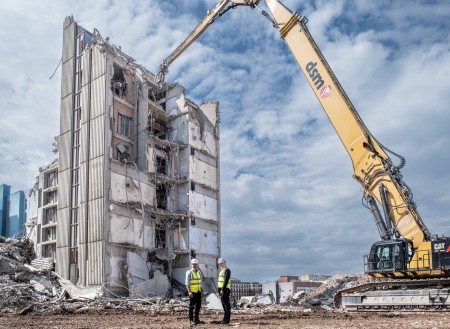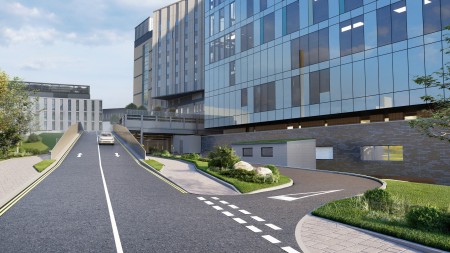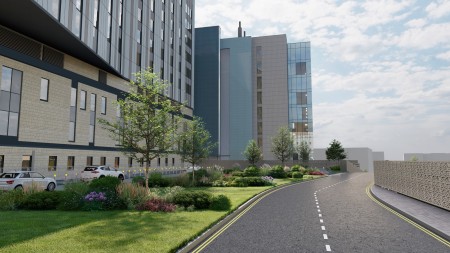For over four decades, the Royal Liverpool University Hospital stood tall at the top of Prescot Street towards the east end of the city. Since opening its doors in 1978, the building has become deeply embedded in the fabric of the city, both for its distinctive architecture and the vast number of healthcare services it delivered to millions of people across the region.
The decommissioning and demolition of the old Royal has been underway since the opening of the new hospital in October 2022, carried out by specialist contractors, DSM, and funded by the government’s New Hospital Programme.
This work is now in its final stages, with high-reach demolition of the old 11 storey ward block now complete. DSM will remain on site until October 2025, completing substructure removal of foundations and tunnels and preparing the ground for the future development.

As the city says goodbye to the old Royal, attention now turns to the future of the land on which it stood.
Construction is expected to start this summer on an extended podium and two-way entrance, connecting Mount Vernon Street and Daulby Street, and this improved infrastructure will enhance access to the hospital.


This work is being carried out by BAM Construction and is expected to be completed by Autumn 2026.
NHS University Hospitals of Liverpool Group (UHL Group), which operates the Royal as well as Aintree University Hospital, Broadgreen Hospital and Liverpool Women’s Hospital, is developing a strategic masterplan for the site in partnership with the New Hospital Programme and Liverpool City Council’s Planning and Regeneration teams. This will provide a framework for all future developments over the next decade.
Working with UHL Group, cancer support charity, Maggie’s, is currently going through the local authority planning process for a new Liverpool centre, which would be located on part of the old hospital site near Prescot Street and will benefit cancer patients, as well as family and friends, from across the region. This project has been commissioned, designed and funded by the Steve Morgan Foundation. Subject to planning permission being granted, the Maggie’s centre is expected to be opened in 2027.
In partnership with UHL Group, the University of Liverpool is also continuing to develop early plans for Health Innovation Liverpool, a health and life sciences campus within the future strategic masterplan. Health Innovation Liverpool would house medical, dental and nurse training facilities for future generations of healthcare professionals, conduct healthcare research with the NHS to benefit the Liverpool population and house companies to power the Liverpool City Region Life Science growth agenda.
James Sumner, Chief Executive of NHS University Hospitals of Liverpool Group, said: “Demolishing the old site in such close proximity to the new Royal and neighbouring buildings has been a complex project and reaching this milestone is a significant achievement. The immediate work we have planned for the extended podium entrance will make a real improvement to how people access the site.
“Further redevelopment is subject to planning and funding, like any new building work, and we are working closely with partners to develop a masterplan that will have the health and wellbeing of our patients and local communities at its heart.”
